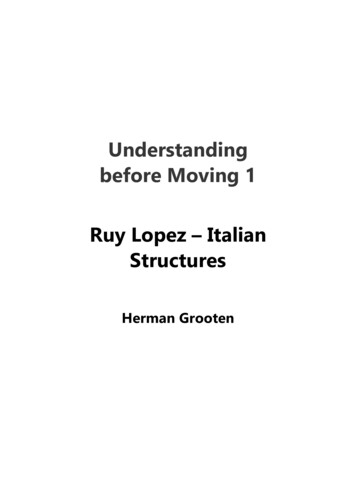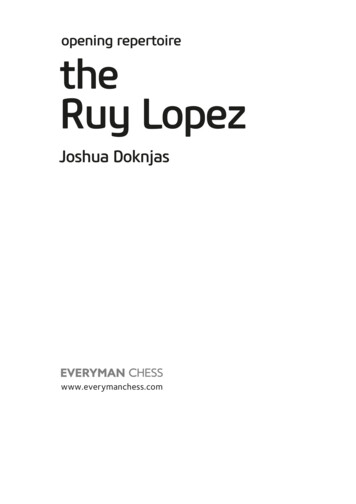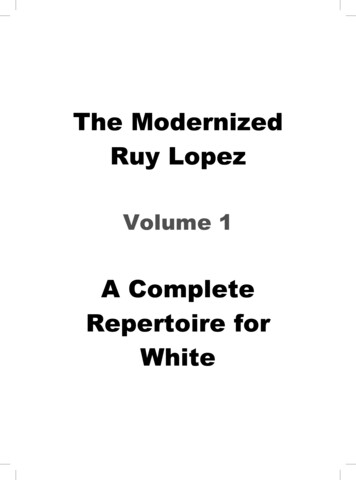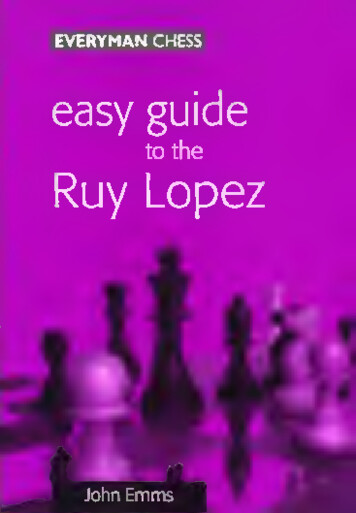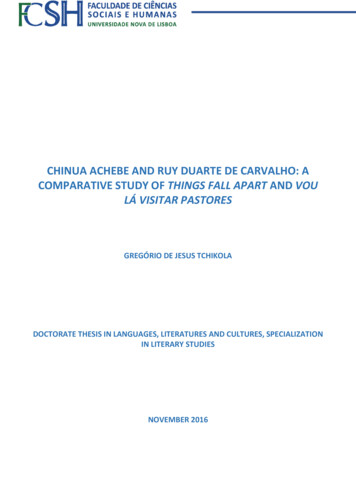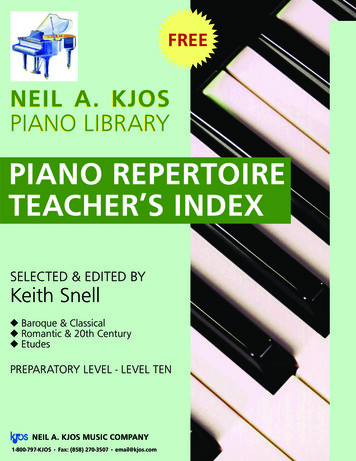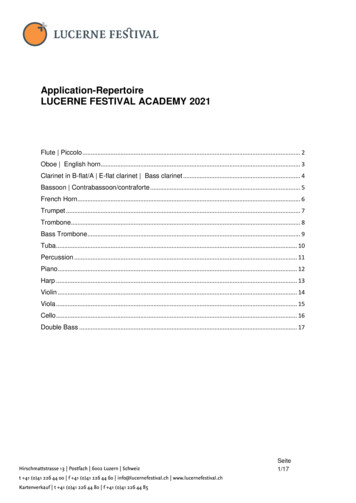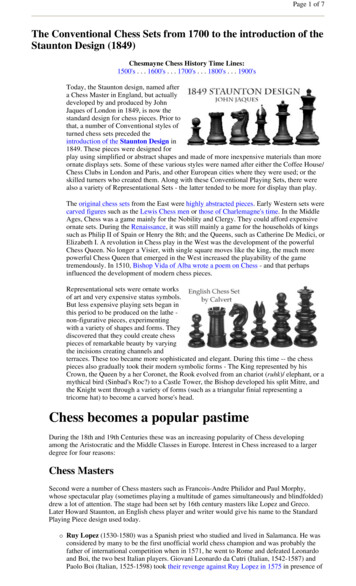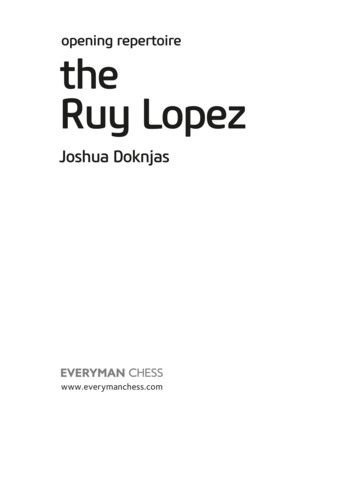
Transcription
opening repertoiretheRuy LopezJoshua Doknjaswww.everymanchess.com
About the AuthorJoshua Doknjas is a FIDE Master from Canada who has enjoyed success competing internationally. He has won seven national titles for his age and tied for 1st in the 2019 U18 NorthAmerican Youth Chess Championship. This is his second book for Everyman Chess.Also by the Author:Opening Repertoire: The Sicilian Najdorf (with John Doknjas)
ContentsAbout the Author3Bibliography5Introduction7Part One: Classical Systems1 The Zaitsev: 9.Íb7 and Sidelines92 The Chigorin: 9.Ìa5363 The Breyer: 9.Ìb870Part Two: Fashionable Lines4 The Anti-Berlin: 4 d3875 The Open Variation1346 The Anti-Marshall: 8 a4159Part Three: Sharp Tries and Sidelines7 Systems with 5.b5 and 5.Íc51868 Systems with .g6 and .Ìge72179 The Schliemann23610 Rare Lines257Index of Variations278Index of Complete Games285
IntroductionThe Ruy Lopez is one of the most rich and diverse openings. The game can easily lead toa complicated and strategic struggle, or a sharp fighting game, where White aims to attackon the kingside while Black plays for a queenside expansion. The wide variety of interesting positions that can be reached out of the opening greatly contributes to the longevity ofthe Ruy Lopez. In recent years, many top players such as Fabiano Caruana, MaximeVachier-Lagrave, and Viswanathan Anand have employed this opening as a major part oftheir repertoire.This book is divided into three parts.Part OnePart One examines the classical systems, including the Zaitsev, the Chigorin, and theBreyer. Over the years, these systems have declined a bit in popularity because White canoften obtain some pressure on Black’s position, which can be unpleasant to defend in practice. However, the lines are quite complicated strategically and White should pay close attention to the typical ideas and plans for both sides.Part TwoIn Part Two, we’ll move on to the fashionable lines: the Berlin, the Open Ruy Lopez, and theMarshall. These lines are frequently seen at the top level because of their solidity and objective strength. Many of the variations are quite concrete as Black often aims to equalizeimmediately out of the opening. For our repertoire, we’ll try to challenge Black by enteringcomplicated and strategic positions. Therefore, I recommend the 4 d3 Anti-Berlin, 9 c3 inthe main line of the Open Ruy Lopez, and the 8 a4 Anti-Marshall.Part ThreePart Three covers Black’s sharp tries and sidelines: 5.b5 and 5.Íc5, .g6 and .Ìge7 systems, the Schliemann, and rare lines. In many of these variations, Black plays for active andrapid development. However, his position is often compromised by either allowing Whiteto take control of the centre or by creating a weakness for White to attack.7
Opening Repertoire: The Ruy LopezHow to Get the Most out of This Bookb I highly encourage readers to pay close attention to the questions and exercises inevery game. This is because they can help to understand the instructive momentsof the game and some of the important concepts to remember.b Play through the games. All of the games I selected for this book feature high-levelplayers, and many of them display useful middlegame ideas that can be applied insimilar types of positions.b Read the short conclusion at the end of each game as it summarizes the importantideas and variations that were covered.AcknowledgementsI would like to thank my family for their support and encouragement throughout this project, as well as Byron Jacobs and the team at Everyman Chess for making it possible.Joshua Doknjas,Canada,November 20198
Chapter FourThe Anti-Berlin: 4 d3The Berlin is one of the most popular choices for Black against the Ruy Lopez at the toplevel. This is mainly due to its solidity, as it is very difficult for White to play aggressivelyagainst this variation. Our repertoire against the Berlin is based on the 4 d3 Íc5 5 Íxc6dxc6 6 0-0 variation. The play here is quite strategic and complicated, where there is lots ofscope to outplay the opponent. In many of the variations, White fights for control of thecentre with c3 and d4 or on the queenside with a3 and b4.W ][DWDPDNDW][P)PDW)P)][ NGQDRIW]W--------WGame 14 looks at Black’s 4th move sidelines after 4 d3: 4.Ìe7 and 4.d6. Both of thesemoves are solid, but a bit passive, and White has good chances for an edge in these lines. Inthe game, White develops his pieces actively and accurately prevents Black’s main ideas. Atsome point, White loses most of his advantage, but manages to win the game due toBlack’s weakened kingside.Game 15 covers Black’s sidelines in the diagram shown above, namely 6.Ëd6 and 6.Íg4.6.Ëd6 is a slightly awkward square for Black’s queen, as it would be a problem for Black if87
Opening Repertoire: The Ruy LopezWhite is able to play Ìbd2-c4. Still, Black’s position is pretty solid and White should play accurately to secure an advantage. 6.Íg4 was Black’s choice in the game and led to very sharpplay. The complications favour White, but the positions are rather tricky. White plays the opening very well and obtains a nearly winning position, but blunders late in the game.Game 16 moves on to the solid 6.Íd6 variation. Against this move, we’ll see howWhite can try to put some pressure on Black’s queenside with Ìbd2-b3-a5. In the game,White gains a better pawn structure out of the opening and a promising position, but theplay quickly becomes very complicated where both sides have their chances.Game 17 examines the 6.Ëe7 variation, where Black aims to develop actively with.Íg4 followed by .Ìd7. In this game, we’ll see how White can continue energetically andput pressure on Black’s position. The play can easily become quite sharp, as White oftenplays b4 and g4 to gain space and restrict Black’s bishops.Game 18 begins our analysis of the 6.Ìd7 variation, which we meet by playing 7 c3 followed by 8 d4. In this game, we’ll look at some of Black’s less common tries, where White’sstrong pawn centre can be very unpleasant for Black to play against. In the game, Blackmanages to obtain some counterplay with .f5, leading to a complicated fight.W ][DW)WDNDW][P)WDW)P)][ NDQDRIW]W--------WGame 19 examines 9.f6 and 9.Ëe8, Black’s two main options in the diagram shownabove. The play is very complicated here, and White generally tries to put pressure onBlack’s e5-pawn, while Black will either gain space on the queenside, or transfer his piecestowards the kingside. In the game, Black struggles to find a good plan and White plays accurately to obtain a better position and slowly convert his advantage.Game 14F.Caruana-A.NaiditschGRENKE Classic, Karlsruhe/Baden Baden 20181 e4 e5 2 Ìf3 Ìc6 3 Íb5 Ìf6 4 d3 d688
The Anti-Berlin: 4 d3Others:a) 4.Íc5 is the main line and we will analyse it in the next five games of this chapter.b) 4.Ìe7 is a rare idea. Black aims for a solid, but slightly passive set-up with .c6 and.d6. 5 Ìc3 (of course not 5 Ìxe5? c6 6 Íc4 Ëa5 ) and now:b1) 5.Ìg6 6 d4, when Black has:b11) 6.Íb4 was tried in D.Navara-M.Luch, Czechia 2006, White should play 7 dxe5!Ìxe4 8 Ëd4 Ìxc3 9 bxc3 Íe7 and here 10 h4! is very strong. If Black plays 10.h5 (10.c611 Íc4 is excellent for White, as h5 is coming next) then White can play 11 e6, intending tomeet 11.fxe6 with 12 Ëxg7. This takes advantage of 10.h5, which weakened the g6knight’s protection. Without the inclusion of h4 and .h5, Black would be winning becauseof .Íf6!b12) 6.exd4 7 Ëxd4! (not 7 Ìxd4? when Black easily gains counterplay against White’scentre after 7.c6 8 Íd3 Íc5 9 Íe3 d6 followed by .0-0 and .Îe8) 7.a6 8 Íc4 d6 9 h4!gives Black major problems on the kingside. 9.h5 is met by 10 Ìg5, and one interestingvariation is 10.Ìe5 11 Íf4! (the simple 11 Íe2 also gives White a clear advantage) 11.c512 Ëxe5 ! dxe5 13 Íxf7 Êe7 14 Íxe5 and despite being up a queen for a knight and twopawns, Black is completely lost in this position. One of White’s ideas is to play Îd1 followedby Íxf6 and Ìd5.b2) 5.c6 6 Íc4W ][DWHPDNDW][P)PDW)P)][ WGQIWDR]W--------WNow Black has two main options:b21) 6.Ìg6 7 h4! (7 d4?! exd4 8 Ëxd4 is met by 8.b6! followed by .Íc5, giving Blackactive play) 7.h5 8 Ìg5 d5 9 exd5 b5 (9.cxd5? is a blunder due to 10 Ìxd5! Ìxd5 11 Ëf3;the game Z.Efimenko-A.Cherniaev, Coventry 2005, continued 11.Íe6 12 Ìxe6 fxe6 13Íb5 Êe7 14 Íg5 Ìf6 15 Ëxb7 and White was completely winning) 10 Íb3 cxd5 11d4! (11 Ìxb5? wins a pawn, but gives Black active play after 11.Íc5 and .Íg4 will becoming soon) 11.e4 12 Ëe2 a6 13 f3 was excellent for White in B.Socko-M.Luch, Warsaw2014.89
Opening Repertoire: The Ruy Lopezb22) 6.d6 and now:b221) 7 0-0 h6 was quite solid for Black in I.Saric-S.Fedorchuk, Rio Achaea 2018, playcontinued 8 d4 Ëc7 9 Ìh4!? (9 h3! looks a bit stronger, and should give White a slightedge) 9.g6? (the active 9.g5! leads to a roughly balanced game) and here White couldhave played 10 dxe5! dxe5 11 f4 obtaining a clear advantage. For example, 11.Íg7 12 fxe5Ëxe5 13 Íe3 followed by Íd4.b222) 7 d4! exd4 8 Ëxd4 (8 Ìxd4 was tried in A.Sherwood-T.Rosenhöfer, correspondence 2018, and following 8.Ìg6 9 Íb3 Íe7 10 0-0 0-0 11 h3 Îe8 12 Îe1 Íf8, Black’s position was quite solid, though White was able to put Black under some pressure) 8.Ìg6 9h4 looks similar to some of the variations we saw after 6.Ìg6 7 h4, but here Black also hasthe additional possibility of playing 9.Íg4!? (9.Ëb6 10 Íe3 Ëxd4 11 Íxd4 Ìg4 12 h5 ledto a much better endgame for White in N.Matinian-S.Soysal, Batumi 2018) Still, Whiteshould retain slightly better chances after 10 Ìg5! Ìe5 11 Íf4 Ëc7 (or 11.h6 12 Íxe5hxg5 13 Íg3) 12 f3 Ìxc4 13 Ëxc4.c) 4.Íd6 looks like an awkward square for the bishop, but Black’s position is still fairlysolid. Play may continue 5 c3 a6 6 Ía4 0-0 7 0-0 Îe8 and now:c1) A.Lanc-A.Malashenkov, correspondence 2017, saw 8 h3, but this seems to be slightlyinaccurate. After 8.h6 9 Îe1 Íf8, 10 d4 was played with the idea of meeting 10.exd4with 11 e5, but the inclusion of h3 and .h6 takes the sting out of this plan. This is becauseWhite is unable to use the g5-square for his knight after 11.Ìd5 12 Íb3 Ìb6.c2) Instead, White should play 8 Îe1!, as here 8.Íf8 9 d4! is quite dangerous for Black.For example, 9.exd4? 10 e5 Ìd5 11 Íb3 and White is prepared to play Ìg5 next.5 0-0 Íd7Others:a) 5.g6 6 d4! Íd7 (6.exd4?! runs into 7 e5!) 7 d5! (7 Îe1 transposes to 5.Íd7 6 Îe1g6, which we will examine below) aims to take advantage of Black’s slightly inaccuratemove order. Play may continue 7.Ìe7 (or 7.Ìb8 8 Ëe2 Íg7 9 Íxd7 Ìbxd7 10 c4 a5 11Ìc3 Ìc5 12 Ìe1 and White had a pleasant position in F.Nepustil-S.Kudela, correspondence 2015) 8 Íxd7 Ìxd7 9 c4 Íg7 10 Íe3 h6 11 Ìfd2 f5 12 f3 f4 13 Íf2 g5 14 Ìc3 Ìg6and in W.So-E.L’Ami, Batumi 2018, and White played the slightly surprising 15 c5!? andobtained good play. But 15 b4! seems best and has the idea of playing c5 next. Black willfind it difficult to create a powerful kingside attack without his light-squared bishop.b) Black can obtain the bishop pair with 5.a6 but White will have good play in the centre after 6 Íxc6 (not 6 Ía4?! as Black can play 6.b5 7 Íb3 Ìa5) 6.bxc6 7 Îe1 and nowBlack has:b1) 7.Íe7 8 d4 exd4 9 Ìxd4 Íd7 is a solid, but passive set-up. The easiest route to anedge seems to be 10 c4! (10 Ìc3 0-0 11 Ëf3 should also be good for White) 10.0-0 11 Ìc3Îe8 12 Ëf3 h6 13 Íf4 and Black’s position is unpleasant.b2) Black tried 7.Íg4 in S.Karjakin-V.Kramnik, Paris (blitz) 2018, and here I think Whiteshould play 8 c3 (instead, the game continued 8 Ìbd2 Íe7 9 h3 Íh5 10 Ìf1 Ìd7 andBlack had a solid position) 8.Íe7 (8.c5 transposes to 7.c5 8 c3 Íg4) 9 Íe3 Ìd7 10 Ìbd290
The Anti-Berlin: 4 d30-0 11 d4 with a slight edge.b3) 7.c5!? fights for control of the important d4-square.W ][DWDPDNDW][P)PDW)P)][ NGQ WIW]W--------W8 c3 and now:b31) 8.Íe7 9 d4 cxd4 10 cxd4 0-0 11 Ìc3 (the immediate 11 dxe5 dxe5 12 Ëc2 followed by Ìbd2 also looks good for White) 11.Íb7 12 dxe5 dxe5 13 Ëc2 Íd6 14 Íg5 gaveWhite a comfortable edge in S.Ventura Monfort-J.Lario Cortés, correspondence 2014.;b32) 8.Íg4 9 h3 gives Black a choice:b321) 9.Íh5?! runs into 10 d4! and if 10.cxd4 (10.Ìd7 is more solid, but White ismuch better after 11 Íe3) 11 cxd4 exd4, then White wins after 12 e5 dxe5 13 g4! (thismove is why White needs to insert 9 h3 Íh5 before playing d4) 13.Íg6 14 Ìxe5 Íe7 15Ìc6.b322) 9.Íxf3 gives up the bishop pair, but makes it more difficult for White to play d4.Following 10 Ëxf3 Íe7, White has:b3221) 11 Íe3 was tried in Wei Yi-R.Rapport, Tbilisi 2017, but after the interesting manoeuvre 11.Ëb8!? 12 b3 a5 13 d4?! (13 Ìd2! should be preferred, with the idea of meeting13.a4 with 14 Îeb1) 13.a4! Black had no problems equalizing.b3222) 11 Ìd2! 0-0 12 Ìc4 a5! Looks best, preventing Ìa5, but White still has a slightedge here. One sample line is 13 a4 Ìd7 14 Ëg4 Ìb6 15 Ìxb6 cxb6 16 f4! and White develops good play on the kingside.c) 5.Íe7 is a solid, but slightly passive set-up. Following 6 c3 0-0 7 Îe1 Black has 3main moves:c1) 7.Íd7 transposes to 5.Íd7 (our main game).c2) 7.Íg4 8 Ìbd2 Ìd7 9 h3 Íh5 10 Ìf1 a6 was tried in P.Harikrishna-R.Stern, Germany 2016, the game continued 11 Ía4 Ìc5 12 Íc2 Ìe6 13 Ìg3 and White was slightlybetter. But the energetic 13 g4! looks even stronger, for example, 13.Íg6 14 Ìg3 Ìg5 15Êg2! as in S.Ter Sahakyan-M.Bartel, Gjakova 2016, was promising for White. The game saw15.Ìxf3 16 Ëxf3 Íg5 and here 17 Íxg5 Ëxg5 18 Îh1! would be better for White.91
Opening Repertoire: The Ruy Lopezc3) 7.a6 8 Ía4 b5 (8.Îe8 9 Ìbd2 b5 transposes to 8.b5 9 Íc2 Îe8; while 8.Íg4 9Ìbd2 Ìd7 is a rather slow plan that should be met energetically: 10 h3 Íh5 11 Íc2 Êh812 g4! Íg6 13 Ìf1 Ìb6 14 Ìg3 d5 15 Ëe2 f6 16 h4! and White had an excellent position inK.Alekseenko-A.Naiditsch, Gibraltar 2019) 9 Íc2 leads to another split:c21) 9.Îe8 10 Ìbd2 Íf8 11 a4 (11 d4 exd4 12 cxd4 Íg4 leads to unclear play) 11.Îb812 Ìf1 h6 13 axb5 axb5 14 d4 exd4 15 Ìxd4! Íd7 16 Ìg3 Ìe5 17 f4 was unpleasant forBlack in M.Zordick-H.Packroff, correspondence 2017.c32) 9.d5 10 Ìbd2 dxe4 (10.d4 11 cxd4! exd4 12 a3 Ìd7 13 Ìb3 was tried in A.MuñizPardiño-J.Schwarz, correspondence 2018 – the game continued 13.Ìde5 14 Ìxe5 Ìxe515 f4 and White obtained a very pleasant advantage; while 10.Íg4?! 11 h3 Íh5 12 g4!Íg6 13 Ìh4 d4 14 Ìdf3 Íc5 15 a3 gave White an excellent position in A.Kasyan-L.Pospísil,correspondence 2016) is probably Black’s best choice, but White should have a risk-freeslight edge in this line. After 11 dxe4 Íe6 12 a4, Black has:c321) 12.b4 13 Ëe2 Ëc8 14 Ìc4 Ìd7 15 a5!? (15 Ìg5! gains the bishop pair and lookspretty good for White) 15.f6?! (15.Ëb7! should be preferred, when White is slightly betterafter 16 Ìe3) 16 Ìe3 gave White good control over the d5 and f5-squares in S.MovsesianZ.Almasi, Istanbul 2012.c322) 12.Ëb8!? 13 Ëe2 Ëb7 14 b4! gained space on the queenside and made it difficult for Black to find an active plan in R.Hall-V.Iotov, correspondence 2015.c323) 12.Íc5 13 Ëe2 Ía7 14 b4! Ìh5 and in F.Caruana-J.Gustafsson, Dortmund 2012,White played 15 Ìf1 and gained an advantage (15 g3!? prevents .Ìf4 and is also betterfor White).6 Îe1!W ][DWDPDNDW][P)PDW)P)][ NGQ WIW]W--------WQuestion: Why is 6 Îe1 more accurate than 6 c3 - ?Answer: Because Black hasn’t yet shown where he plans to develop his f8-bishop (to e7 orto g7), so White wants to maintain the possibility of playing c4 in one move. If Black devel92
The Anti-Berlin: 4 d3ops his bishop to e7, White will play c3, as we will see in our main game. If Black tries 6.g6,then we can play 7 d4!, obtaining a fairly good version of a King’s Indian pawn structure.Still, 6 c3 is completely playable. The position after 6.g6 7 Îe1 Íg7 8 Ìbd2 0-0 is fairlysound for Black, but White can fight for a small advantage here.6.Íe7Or:a) 6.g6 7 d4! Íg7 8 d5 Ìe7 9 Íxd7 exchanges off Black’s light-squared bishop whichusually plays a vital role in Black’s kingside attack. 9.Ìxd7 10 Íe3 and now:a1) 10.0-0 11 c4 h6 (11.f5?! is met by 12 Ìg5!) 12 Ìfd2 f5 13 f3 is very similar to the10.h6 variation.a2) 10.h6 11 Ìfd2 f5 12 f3 and here we’ll look at two high-level games:a21) 12.h5 13 c4 b6 was tried in S.Sjugirov-P.Ponkratov, Yaroslavl 2018, in order to slowdown White’s queenside attack. The game continued 14 Ìc3 f4 15 Íf2 g5 16 b4 Ìf6 17 c5Ìg6 18 Îc1 (18 Ëa4 ! would have been even more unpleasant for Black) 18.0-0 19 cxd6cxd6 20 Ìb5 Îf7 21 Îc6 and White had excellent queenside play.a22) 12.Ìf6 13 c4 c6!? (13.0-0 14 Ìc3 f4 looks natural in this position, but isn’t veryeffective, as Black doesn’t have his light-squared bishop; play may continue 15 Íf2 g5 16c5 Ìg6 17 b4 h5 18 Ìc4 and White has excellent queenside play, while it’s difficult forBlack to do much on the kingside) was played in L.Dominguez Perez-T.Radjabov, Dortmund2019, the game continued 14 Ìc3 0-0 15 Ëb3 cxd5 16 cxd5 Îf7 17 Îac1 (17 a4 also deserved consideration) 17.fxe4 18 Ìdxe4 and White had a fairly comfortable edge.b) 6.a6 7 Íxc6 Íxc6 8 c4! is a strong move, making it much more difficult for Black tofind active play. Black needs to decide where he wants to develop his bishop:b1) 8.g6 9 Ìc3 Íg7 10 d4 0-0 (10.exd4 11 Ìxd4 0-0 12 f3 is better for White, as it isvery difficult for Black to create play here) 11 dxe5 dxe5 12 Ëc2 was good for White inS.Lobanov-S.Himanshu, Leiden 2018, because he could soon begin a queenside expansionwith b4-b5.b2) 8.Íe7 was tried in I.Dolgov-V.Gorozhantsev, correspondence 2017, the game continued 9 Ìc3 0-0 10 d4 Îe8 11 Ëc2 exd4 12 Ìxd4 Íd7 13 Íf4 and Black’s position wasvery unpleasant.7 c3 0-0 8 h38 Ìbd2 is the main line and White should also be slightly better here.8.Îe8 9 a4!93
Opening Repertoire: The Ruy LopezW ][DW)PDNDP][W)WDW)PD][ NGQ WIW]W--------WQuestion: What is the purpose of 9 a4 - ?Answer: 9 a4 gains space on the queenside, while also preventing Black from playing .a6and .b5.9 Ìbd2 is more natural and fully playable as well. Black will likely play 9.Íf8, preparing .Ìe7, so White should play 10 Ía4! and after 10.Ìe7 11 Íc2 Ìg6 12 d4 c6 13 Ìf1White has a slight edge.9.Íf89.a6 10 Íc4 Ìa5 11 Ía2 c5 aims to play .b5, but White can fight back with 12 b4 (12Íg5 should also give White an edge) 12.cxb4 13 cxb4 Ìc6 14 Íd2.10 Íg5!Others are possible:a) 10 Íc4!? looks like a good alternative, preventing Black’s main idea of 10.Ìe7? ashere White wins with 11 Ëb3. 10.h6 is stronger, but White is slightly better after 11 a5 a612 Ìbd2 Íe6 13 Íxe6 Îxe6 14 c4!, restricting Black’s central play.b) 10 a5 gaining more space on the queenside also deserves consideration.10.h6 11 Íh4 g5 12 Íg3 Ìe712.Ìh5 seems to threaten .Ìxg3, but White can ignore this by playing 13 Ìbd2! andnow:a) 13.g4? runs into 14 Íh4! Íe7 15 Íxe7 Ëxe7 16 Ìh2! picking up the g4-pawn.b) 13.Ìf4 is probably best. White should meet this with 14 Ìf1 Íg7 15 Ìe3 and slowlyprepare to play d4.c) 13.Ìxg3 14 fxg3 and White is prepared to play g4 next, followed by Ìf1-g3. For example, 14.Ìe7 15 Íxd7 Ëxd7 16 g4 Ìg6 17 Ìf1 with a clearly better position for White.13 Íxd7 Ëxd7 14 Ìbd2 Ìg6 15 Ìc4 Îad8 16 Ìe3 d516.c6 preparing .d5 was more solid. After 17 Ëc2 d5 18 Îad1 White will aim to exploit94
The Anti-Berlin: 4 d3Black’s weak light-squares on the kingside with either Ìf5 or Ìh2-g4.17 exd5 Íg717.Ìxd5 immediately runs into 18 Ìg4!W ][DW)PHNGP][W)WDW)PD][ WDQ WIW]W--------WExercise: Black is prepared to play .Ìxd5 on his next move and achievea comfortable game. How can White make things difficult for Black?Answer: 18 d4!Challenging Black in the centre and attacking the e5-pawn.18 c4 c6! Is fine for Black, as after 19 dxc6 bxc6 White is unable to defend the d3-pawn.18.exd4Or:a) 18.e4 19 Ìd2 is good for White. Black is unable to play 19.Ìxd5?! because of 20Ìxd5 Ëxd5 21 Íxc7.b) 18.Ìxd5 19 dxe5 gives White an extra pawn in the endgame arising after 19.Ìxe320 Ëxd7 Îxd7 21 Îxe3.19 cxd4?!19 Ëxd4! is best, when Black can try:a) 19.Ìxd5 20 Ëxd5 (or 20 Ëxa7) 20.Ëxd5 21 Ìxd5 Îxe1 22 Îxe1 Îxd5 23 Íxc7and Black faces a very difficult defence in this endgame.b) 19.Ìe4 20 Íe5! (but not 20 Ëxa7?! f5!, and Black gets counterplay) 20.Íxe5(20.Ìxe5 21 Ëxe4 is a safe extra pawn for White) 21 Ìxe5 Îxe5 22 Ìg4! Îxd5 23 Ëxe4and White has a much better position.19.Ìxd5 20 Ìxd5 Îxe1 21 Ëxe1 Ëxd5 22 Íxc7 Îc8 23 Îc1 Íxd4 24 Ëd2 Ëd7 25 Ìxd4Îxc7 26 Îxc7 Ëxc7 27 Ìf595
Opening Repertoire: The Ruy LopezW ][DWDWDWDP][W)W!W)PD][DWDWDWIW]W--------WThe position is close to equal, but the weaknesses around Black’s king give him somedifficulties in defending.27.Êh7 28 g3 Ìe5 29 Ëe3 Ìc4?!29.f6! was stronger, supporting the knight on e5.30 Ëc3 Ëe5 31 Ëd3 Ìxb2 32 Ëc2 Ëe1 33 Êg2 Ëd1 34 Ëe4 Ëxa4?34.Ëd7! threatens to play .Ëc6 or .Ìxa4.35 Ëxb7 Ëa2 36 Ìe3 Êg7 37 Ëb4 Ëb1 38 g4 Êg8 39 Ìf5 Ëc2 40 Ëb8 Êh7 41 Ëb7 Êh842 Ëe7 1-0Black’s 4th move sidelines in the Berlin give White good chances to obtain a slight edge.In the 4.d6 variation after 5 0-0 Íd7, it is important to remember the accurate 6 Îe1!,which allows White to meet 6.g6 with 7 d4! and obtain a good King’s Indian structure. Inour main game, Black opted for a .Íe7 set-up, but White was able to put Black undersome pressure by gaining space on the queenside (9 a4!) and then preventing Black’s mainidea of .Ìe7 with 10 Íg5!Game 15P.Leko-D.NavaraSpanish League 20181 e4 e5 2 Ìf3 Ìc6 3 Íb5 Ìf6 4 d3 Íc5 5 Íxc6 dxc6 6 0-0 Íg496
The Anti-Berlin: 4 d3W ][DWDPDNDW][P)PDW)P)][ NGQDRIW]W--------WA very ambitious idea, Black is hoping to develop actively with moves such as .Ìd7,.f6, and .Ëe7. However, this can only be achieved if White plays slowly.We will look at 6.Íd6, 6.Ìd7, and 6.Ëe7 later in this chapter.6.Ëd6 is similar to the more popular 6.Ëe7 variation, but here the queen on d6 canbe more easily attacked by Ìbd2-c4. However, the advantage of 6.Ëd6 is that it puts pressure on White’s d3-pawn.Question: Why can’t White play 7 h3 here?Answer: 7 h3?! is a natural looking move, but one which White should be very carefulabout playing if Black hasn’t castled kingside. Black can play 7.Îg8! followed by .g5, putting White in serious danger. White can try 8 c3 intending to meet 8.g5 with 9 d4, but after 9.g4! the play becomes very sharp, and it looks quite dangerous for White.After 7 c3, Black can play:a) 7.Íb6 8 Ëc2! (8 d4 runs into Black’s main idea behind 7.Íb6: 8.Íg4! 9 Ìbd2 Ìd7and Black should be able to obtain good counterplay against White’s centre) protecting thed3-pawn in preparation for Ìbd2. One sample line is 8.Íg4 9 Ìbd2 Ìd7 10 h3 Íxf3 11Ìxf3 0-0 12 Îd1 and White has a better position, as he can slowly prepare to play d4 whileBlack lacks active play.b) 7.0-0?! was tried in J.Vozda-R.Postl, correspondence 2009, and White obtained anexcellent position after 8 d4 Íb6 9 a4 a5 10 Ëc2 Ìd7 11 Ìa3!97
Opening Repertoire: The Ruy LopezW ][HW)WDNDW][W)QDW)P)][ WGWDRIW]W--------WQuestion: What is the point of developing the knight to a3 instead of d2?Answer: White developed his knight to a3 instead of d2 so that 11.exd4 12 cxd4 Íxd4? canbe met by 13 Îd1 c5 14 Ìb5! Ëc6 15 Íf4 with a winning position.c) 7.Íg4 8 Ìbd2 and now:c1) 8.Ìd7 9 h3 Íxf3 and in M.Kravtsiv-Z.Almasi, Heraklio 2017, White played 10 Ëxf3,but the more accurate recapture would have been 10 Ìxf3! because the knight can helpWhite to play d4 and expand in the centre. The knight can also put some pressure onBlack’s kingside, this is seen after 10.0-0 11 Ìh4! (the natural 11 d4 should be slightly better for White, but Black’s position is solid) 11.Ëe6 (11.g6 weakens the kingside and canbe met by 12 Ëc2 Îfe8 13 Ìf3 followed by gaining space on the queenside with b4 and a4,or Îd1 and d4) 12 Ìf5 Îfe8 13 Ëg4 Íf8 14 Îd1 (14 f3!? and d4 next also looks good) andWhite’s position is much more pleasant. His main plan is to keep his centre well-supportedand play d4 soon.c2) 8.Ëxd3 leads to a better endgame for White after 9 Ìxe5 Ëe2 10 Ìxg4 Ëxg4 11Ëxg4 Ìxg4 12 Ìb3 and here Black has two options:c21) 12.Íb6 was seen in A.Manzo-L.Laffranchise, correspondence 2010, but the bishopappeared to be misplaced on b6 after the moves 13 c4! a5 14 c5 Ía7 15 h3 Ìe5 16 Ìxa50-0-0 17 b4 and White obtained a clear advantage.c22) 12.Íe7 looks stronger, but the endgame is still unpleasant for Black. For example,13 Îd1 Ìe5 14 Íf4 Ìc4 15 Îab1 Îd8 (or 15.Îc8 16 Ìd4) 16 Ìd4 is slightly better forWhite.7 h3 Íh57.Íxf3 8 Ëxf3 gives Black two main options:a) 8.0-0 9 Ìd2 Îe8 (9.Ìd7 10 Ìc4 a5 11 a4 Îe8 12 Ëg3 Ëe7 13 Êh1 Íd6 wasM.Rodshtein-B.Bok, Yerevan 2014, and 14 f4! would be quite dangerous for Black) 10 Ìc498
The Anti-Berlin: 4 d3Ìd7 11 Íd2 Îe6!? (protecting the c6-pawn, so that Black doesn’t need to worry about .b5Ìa5!; 11.b5 12 Ìa5 and Ìb7 next gives White an edge) 12 g3 was slightly better forWhite in M.Adams-M.Rodshtein, Tbilisi 2017, but it would be stronger to first play 12 a4!and then after 12.Îg6 13 g3 White can slowly prepare to create play on the kingside.b) 8.Ìd7 9 Ìd2 and now:b1) 9.Íd6 10 Ìc4 Ëe7 11 Ëg3 f6 and in I.Salgado Lopez-O.Korneev, Linares 2015,White was much better after 12 Êh1 (the immediate 12 f4! looks very strong as well).b2) 9.Ëf6 10 Ëxf6 leads to a favourable endgame for White. E.Bacrot-L.Fressinet, Pau2008, saw 10.Ìxf6 11 Ìc4 Ìd7 12 Íd2 and White soon expanded on the queenside withb4 and a4. After this, White prepared to play d4 and took control of the centre, while Blackhad to defend passively.b3) 9.Ëe7 10 Ìc4! (10 a4 was played in E.Inarkiev-D.Jakovenko, Khanty-Mansiysk 2013,and should give White a slight edge, but White can delay this move for now) 10.f6(10.0-0-0?! isn’t effective in this position; following 11 Íd2 f6 12 a3 Ìf8 13 b4 White wasfar ahead with his attack in I.Salgado Lopez-S.Maze, Haguenau 2013) 11 Íd2 leads to another split:b31) 11.0-0 12 Ëg4! (12 a3 followed by b4 was also good for White in M.KanarekD.Mastrovasilis, Suwalki 2017) intending to create play on the kingside; for example,12.Îfe8 13 Êh2 Ìf8 14 g3 followed by f4.b32) 11.b6 12 a3 0-0 13 b4 Íd6 14 Ìe3 Êh8 15 h4! and White was clearly better inE.Sutovsky-L.Fressinet, Khanty-Mansiysk 2010, as he could slowly increase the pressure onthe kingside while Black lacked active play.b33) 11.Ìf8 12 b4 Íd6 13 a4 Ìe6 14 c3 is much better for White. Black will soon castlekingside and White can play moves like g3 and h4-h5, increasing the pressure on Black’sposition.8 g4!W ][DWDPDNDP][P)PDW)WD][ NGQDRIW]W--------W8 Ìbd2 is a simpler approach, avoiding the complications that arise after 8 g4 Ìxg4.However, 8 Ìbd2 allows Black to develop without too many difficulties. Following 8.Ìd799
Opening Repertoire: The Ruy Lopez(8.Ëe7 actually transposes to the 6.Ëe7 variation, which is discussed later in this chapterin Game 17) 9 Ìc4 (9 c3!? is also playable, aiming to later expand in the centre with d4)9.f6 10 c3 Íb6 11 Ëe2 leads to a roughly balanced position.8.Ìxg48.Íg6 9 Ìxe5 Ëe7 10 Ìxg6 hxg6 gives Black the open h-file, but this isn’t enough tocompensate for the extra pawn White has. After 11 Êg2! 0-0-0 12 Ìd2, Black can try:a) 12.Îh7 intending .Îdh8 is simply met with 13 Îh1.b) 12.Ìd7 13 Ìf3 Ìe5 (13.f5? runs into 14 Íg5 Ìf6 15 Ìh4! with a nearly winningposition for White) 14 Íf4 is much better for White.c) 12.Ìh7 13 f4! (13 Ìf3 should be fine for White, but allows unnecessary complications after 13.f5!) is very strong, covering up some of the entry points into White’s position (the g5 and e5-squares). 13.f5 is probably Black’s most dangerous idea, but White canplay 14 Ëf3, when Black is struggling to show any play for the pawn.9 hxg4 Íxg4 10 Íe310 Êg2? looks like a natural way to defend the knight on f3 and was played inK.Alekseenko-L.Babujian, Yerevan 2015, but 10.Ëc8! with the threat of .Íh3 would bevery unpleasant for White. 11 Îh1 is well met by 11.f5.10.Íd6Black’s most popular choice, avoiding the exchange of bishops and supporting the e5pawn. Others:a) 10.Ëf6!? 11 Êg2! (not 11 Ìbd2? Íh3) when Black can play:a1) 11.Íe7?! keeps more pieces on the board, but after 12 Ìbd2 0-0-0 (12.h5 13 Îg1g5 14 Êf1 is perfectly safe for White) 13 Îg1 White is doing very well.a2) 11.Íxe3 12 fxe3 Ëe6W ][DWDP)NDW][P)PDWDKD][ NDQDRDW]W--------WExercise: Find a good plan for White to restrict Black’s kingside play and bringthe g2-king to safety.100
The Anti-Berlin: 4 d3Answer: 13 Îf2! (13 Êf2? runs into 13.0-0 followed by .f5) is an excellent idea andgives White a clear advantage. White’s plan is to play Ìc3, Ëh1, and Êf1-e2. For example,13.h5 14 Ëh1 0-0-0 15 Ìc3 f6 16 Êf1 g5 17 Êe2 and White is much better.b) 10.Íe7!? 11 Êg2! (11 Ìbd2 is met by 11.Ëc8! followed by .f5; while 11 Êh1? appears to be similar to our main game, but the difference is seen in the variation 11.f5 12Îg1 h5 13 exf5? and here, because Black has his bishop on e7 instead of d6, he win with13.e4!, due to the pin on the d-file) and now:b1) 11.Ëc8 threatens .Íh3 and prepares to activate th
Opening Repertoire: The Ruy Lopez 88 White is able to play Ìbd2-c4. Still, Black's position is pretty solid and White should play accu-rately to secure an advantage. 6.Íg4 was Black's choice in the game and led to very sharp play. The complications favour White, but the positions are rather tricky. White plays the open-
